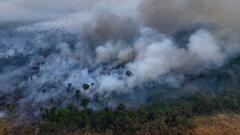Researchers report that 67,000 sq km of tropical forests were lost in 2024—a historic high driven primarily by wildfire activity, prompting fears of an ecological tipping point, particularly in the Amazon. While some regions such as Southeast Asia show progress in reducing deforestation, the overall global trend highlights the urgent need for effective climate policies.
Record Loss of Tropical Forests Raises Climate Concerns

Record Loss of Tropical Forests Raises Climate Concerns
New satellite data reveals the alarming rate of tropical forest destruction, with fires replacing agriculture as the leading cause.
The world's tropical forests, which are critical in combating climate change, faced unprecedented destruction last year, according to new satellite analysis. Researchers estimate that a staggering 67,000 square kilometers (about 26,000 sq miles) of these old-growth forests were lost in 2024—the equivalent of an area nearly the size of the Republic of Ireland, or a shocking 18 football pitches lost every minute.
This extensive loss is attributed primarily to unprecedented wildfire activity, which has surged beyond traditional agricultural clearing for the first time on record. The Amazon rainforest has been particularly hard-hit, suffering through record drought conditions that exacerbated the already dire situation.
"These findings are alarming," said Prof. Matthew Hansen, co-director of the GLAD laboratory at the University of Maryland, which produces these crucial data. He emphasizes the terrifying prospect of a "tipping point" for some forests, especially parts of the Amazon, where they risk an irreversible shift toward savanna landscapes.
A separate study echoed this sentiment, warning of significant dieback in the Amazon if global warming exceeds the vital threshold of 1.5°C. Such an event would not only endanger numerous species within these biodiverse habitats but would also have serious repercussions for global climate health.
Historically, the Amazon has served as a major carbon sink, absorbing more carbon dioxide (CO2) than it emits. However, the increasing frequency of forest fires is leading to an alarming reversal of this trend, releasing an estimated 3.1 billion tonnes of CO2—similar to the total emissions of the European Union.
The recent year was marked by the most severe drought yet in the Amazon, intensified by both climate change and the natural El Niño weather pattern. While some wildfires are started for agricultural purposes, the severe drought created the perfect conditions for uncontrolled fire spread, with Brazil and Bolivia being heavily impacted.
Despite the widespread destruction, there is a glimmer of hope in Southeast Asia. Countries like Indonesia reported a decline in primary forest loss, attributed to effective governmental policies enforcing "no burning" laws. Elizabeth Goldman, co-director of Global Forest Watch, pointed out this progress, noting the essential role of political will in successfully protecting these ecosystems.
Yet, experts caution that while the progress in Southeast Asia is commendable, fluctuations in forest loss in other regions, including Brazil, demonstrate that consistent protective measures are paramount. “You have to keep winning the fight against deforestation,” asserted Prof. Hansen.
As the upcoming UN climate summit COP30 approaches, hosted in the Amazon itself, researchers stress the importance of global cooperation in implementing and promoting effective forest protection schemes. One promising concept under discussion includes incentivizing countries that demonstrate successful forest conservation efforts.
Rod Taylor from the World Resources Institute emphasized the need for innovative solutions to ensure that maintaining forests becomes more economically advantageous than destroying them, a challenge of critical importance in the fight against climate change.





















